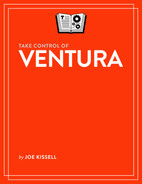Check Your Mac for Compatibility
All currently shipping Macs, as well as most models introduced within the past five years or so, can run Ventura. Sadly, Ventura does drop support for some Mac models that were able to run macOS 12 Monterey.
The next few pages will help you verify that your hardware is fully compatible with Ventura.
Model Support
Macs that can run Ventura include the following:
iMac (2017 or newer)
iMac Pro (2017)
MacBook (2017)
MacBook Air (2018 or newer)
MacBook Pro (2017 or newer)
Mac mini (2018 or newer)
Mac Pro (2019 or newer)
Mac Studio
Unfortunately, that excludes the following models that were able to run Monterey, but can go no further:
iMac (Late 2015)
MacBook (Early 2016)
MacBook Air (Early 2015, 2017)
MacBook Pro (Early and Mid 2015, 2016)
Mac mini (Late 2014)
Mac Pro (Late 2013)
Of course, that list is helpful only if you know which model of Mac you have! This is easy to check: Choose Apple > About This Mac (and, if present, click More Info). You’ll see something like Figure 1; the Overview pane spells out your Mac’s model using Apple’s current terminology. Compare that to the list above and you’re done.

If your Mac isn’t in the list above, then regardless of its age or speed, I’m very sorry to say that it won’t run Ventura.
Even if your Mac is on that list, however, certain Ventura features may not work because they have more stringent processor requirements. I point these out throughout the book.
New Macs that shipped after Ventura was released have Ventura preinstalled; if necessary, you can use the Migration Assistant to transfer files, accounts, and settings from your old Mac, as I explain in my TidBITS article How to Migrate to a New Mac (which is still largely accurate even though it was published in 2016). After your migration, you’ll have some additional steps to complete, as Adam Engst explains in Moving to a New Mac: What’s Left to Do After Migration?.
RAM
Apple hasn’t stated how much RAM Ventura requires, but since all Macs that can run Ventura shipped with at least 8 GB of RAM, that appears to be the effective minimum. For an M-series Mac, most typical users will do just fine with 8 GB, though people doing heavy-duty video, audio, or graphics work may prefer more. An Intel-based Mac with only 8 GB of RAM may yield slower performance than you prefer, even if with everyday tasks.
So, if you have an Intel-based Mac (or an M-series Mac with higher resource needs), and if your Mac’s RAM is user-upgradable, I suggest installing at least 16 GB. But very few people would benefit from the maximum of 128 GB of RAM you can put in a Mac Studio with M1 Ultra chip, let alone the 1.5 TB you can put in a 2019 Mac Pro.
To see how much RAM your Mac currently has installed, choose Apple > About This Mac and look at the Memory line.
Free Disk Space
The amount of free space Ventura requires for installation depends on a number of variables, including which version of macOS you’re upgrading from and which upgrade method you use. I suggest starting with at least 50 GB of free space before downloading the Ventura installer (which itself occupies up to about 12 GB). Some Ventura features will require increasing amounts of disk space as you use them, so it never hurts to have room to grow.
Solid-State Storage
In this book I use the term “disk” to refer to your Mac’s primary storage device. For most of the Macs that can run Ventura, this isn’t really a disk-shaped object at all, but rather a solid-state disk (SSD), which is far, far faster and more reliable than a mechanical hard drive.
Does your Mac have an SSD? Great, nothing to see here! Move on to the next chapter. If not, or if you’re unsure, read on.
Some of the iMac models that support Ventura came in configurations that included either a mechanical hard drive or a Fusion drive, which combines a mechanical hard drive with a smaller SSD. If you have a Mac with a plain hard drive—no SSD, no Fusion drive—you should think twice about installing Ventura (or, indeed, any operating system from Mojave onward). The reason is that these more recent versions of macOS use a new file system called APFS, which is designed for terrific speed and reliability on SSDs (and, to a lesser extent, Fusion drives) but performs very poorly when used for startup volumes stored on mechanical hard drives.
How can you tell? Choose Apple > About This Mac, click System Report, and, under Hardware in the sidebar on the left, select Storage. On the right, with your startup volume selected under Volume, look in the bottom pane, under Physical Drive, for the “Medium Type” heading. Whatever follows is the type of storage your Mac uses. If it says Rotational, you have a mechanical hard drive. If it says SSD, you have either all-SSD storage or a Fusion drive.
If you do have a mechanical hard drive, your options are as follows:
Stick with a much older version of macOS—as in High Sierra or earlier.
Replace your hard drive with an SSD. Numerous companies sell aftermarket SSDs and the tools needed to install them; Other World Computing is one I’ve used. However, tinkering with the innards of an iMac is not for the faint of heart; if you’re not technically adept, you might consider hiring a consultant or repair shop to install it.
Install Ventura on an external SSD, connected via the fastest version of Thunderbolt or USB your Mac supports. At the end of the installation process, migrate your data from your internal hard drive; see Use Migration Assistant.
Resign yourself to a life of contemplation as you wait. Several. Seconds. For. Every. Single. Thing. To. Happen.
